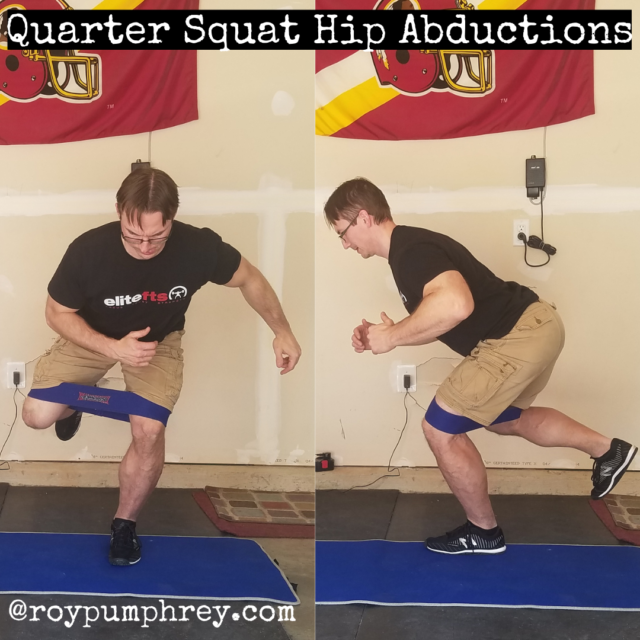
Your Hips are Weak.
Probably super weak.
Especially this muscle:
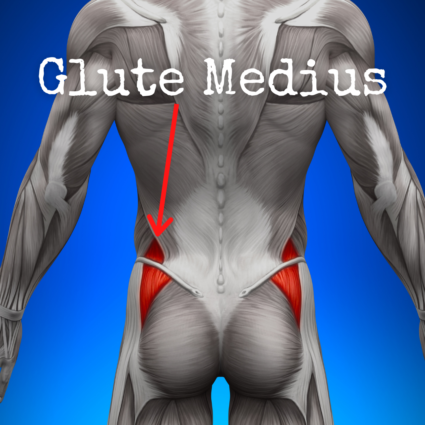
The Glute Medius Or “High Glute”
Role(s) of the Glute Medius:
Truth is, the Glute Med plays several different roles.
The primary function of the GMed is position, movement and load dependent.
“Hip and knee kinetic and kinematic variables related to the development of dynamic knee valgus would appear to be influenced by gluteal muscle strength and EMG activity. The level of influence varies across single leg squatting and landing tasks and would appear superficially to differ between genders, though this was not statistically analyzed. It would appear that G Med (hip abductor muscles) strength and activity have a more important role than G Max (hip extensor (external rotator) muscles) in male subjects in influencing the nature of the motion occurring across all tasks. In females both G Med and G Max would appear to have an equally influential role across all tasks.” – An investigation into the role of gluteal muscle strength and EMG activity in controlling HIP and knee motion during landing tasks
But for sake of time and argument,
The glute med helps control rotation of the hip and provides stability to the pelvis, especially, in single leg stance.
If the glute med is underactive or weak your entire lower half can be thrown into chaos,
“low activity and weakening of the gluteus medius (GM) can causes compensation by the synergist tensor fascia latae (TFL) and quadratus lumborum (QL) (Lee et al., 2013; Clark and Lucett, 2011). Excessive compensatory activity of the TFL pulls the retinaculum of the knee. This moves the patella to the lateral side and causes patellofemoral pain syndrome (Merican and Amis, 2008). Early contraction of the QL occurs when the angle of side-lying abduction is less than 20 degrees. This causes hip elevation and in turn, mobilization and not stabilization of the QL (Page et al., 2010).
Excessive activation of the QL causes the pelvis to move outward, resulting in lateral bending and instability of the lumbar region (Cynn et al., 2006). Therefore, strengthening of the gluteus muscles can affect prevention diseases that may occur in the lumbar region and the knee.” –Difference of Muscle Activity by Pelvic Tilt in Side-Lying Hip Abduction
Does Your IT Band (outer quad), TFL (front hip) or QL (low back) Hurt?
If that’s the case, the Glute Med probably isn’t doing its share and there’s a really solid chance your TFL, IT Band and QL are trying to pick up the slack and control your Femur and Pelvis.
But Does it Matter?
I think so,
“unilateral HAB (Hip abductor) weakness has been associated with an increased risk of injury in sports such as soccer, ice hockey, and running. Furthermore, Gmed strength may be even more important in sports when the center of mass changes direction unexpectedly, requiring strength and stabilization during unilateral stance.“ – Strengthening the Gluteus Medius Using Various Bodyweight and Resistance Exercises
There are LOTS of exercises to activate and strengthen the GMed.
“If the goal of rehabilitation is to preferentially activate the gluteal muscles while minimizing TFL activation, then the clam, sidestep, unilateral bridge, and both quadruped hip extension exercises would appear to be the most appropriate.” – Which Exercises Target the Gluteal Muscles While Minimizing Activation of the Tensor Fascia Lata? Electromyographic Assessment Using Fine-Wire Electrodes
Sure, they activate the GMed effectively, but these are all fairly low-level.
And that’s great for rehab and learning control but its a long way from more complex multipoint movements that rely on the GMed for pelvic control in single leg stance.
Quarter Squat Hip Abductions
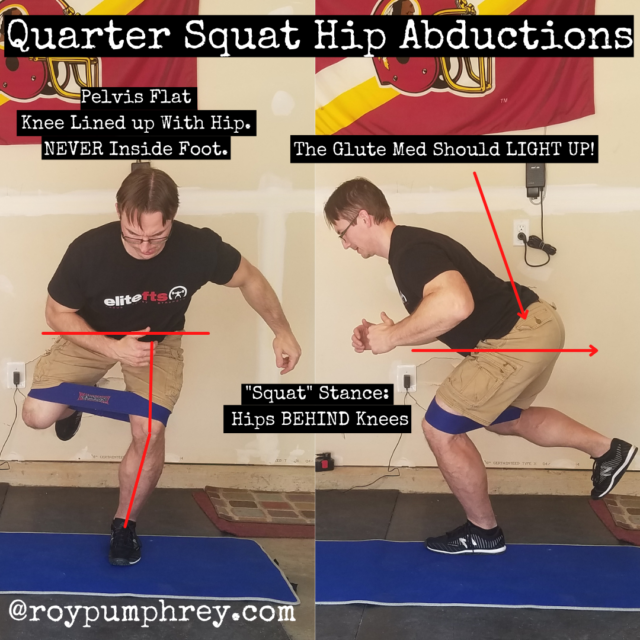
Checklist:
- Get into a hip width stance with a band above the knees.
- Toe- Ankle- Knee- Hip alignment.
- Pick one foot up, bend the knee and extend the hip so the “up” knee is slightly behind the stance knee.
- Don’t allow the torso or hip to rotate
- Try to keep the stance knee still during the movement
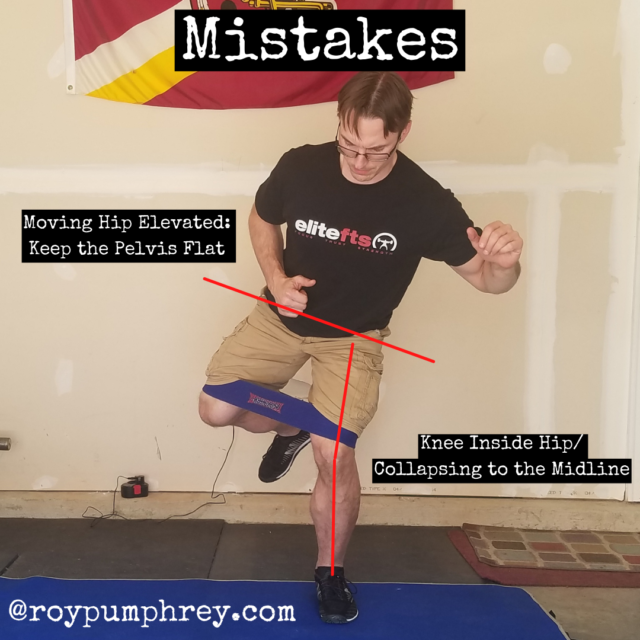
Bro Tips:
- Focus on keeping the unsupported hip “down”/ “flat”
- DO NOT FOCUS ON THE MOVING LEG, its of almost ZERO consequence.
- Active foot, “rooting” or gripping the floor the whole time.
- Of course you can do these without the band to learn the movement.
Why the Quarter Squat?
Look at the universal “Athletic Stance”.
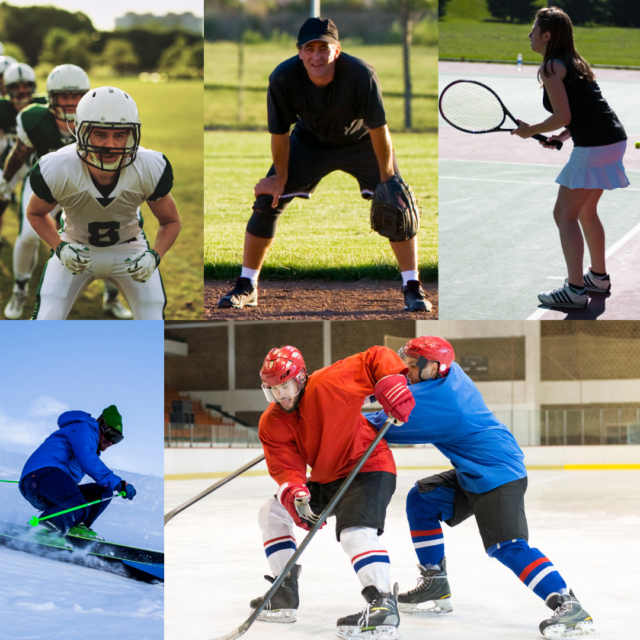
- Shoulder width (or there abouts)
- Knees slightly behind toes to vertical shins.
- Hips BACK behind knees.
- Slight torso HINGE forward
- Chest up, T-shirt logo visible
Remember, we’ve seen the GMed, GMax and other muscles of the pelvic complex vary in terms of activation levels and contribution to movements depending on the load, position (joint angles) and relative strength of the muscle.
So if you want an exercise that transfers to the field, you’ll want to mimic joint angles that resemble the sporting stance/ motions at some point in the exercise. <—–ie, just train through a full range of motion 95% of the time.
But, in a pseudo isometric exercise like this, we should train in the position/ joint angles we’re trying to get the most control in.
Also, this exercise lights the GMed up, regardless, when performed correctly so there is that.


